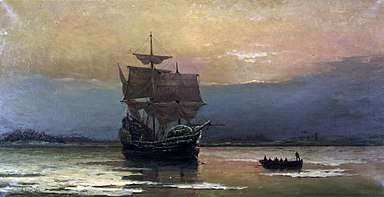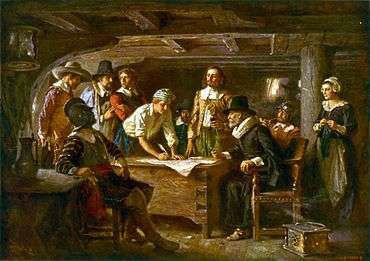John Carver (Plymouth Colony governor)
| John Carver | |
|---|---|
| 1st Governor of Plymouth Colony | |
|
In office 1620–1621 | |
| Preceded by | None |
| Succeeded by | William Bradford |
| Personal details | |
| Born |
before 1584 England |
| Died |
April 1621 Plymouth Colony |
| Resting place | Coles Hill Burial Ground |
| Nationality | English |
| Spouse(s) |
Mary de Lannoy m. 1609, d. 1609 Katherine White m. before 1615 - d. May 1621 |
| Children | 2 (predeceased both parents) |
| Occupation | Deacon |
| Profession | Governor |

John Carver (before 1584 – 1621) is credited with writing the Mayflower Compact and was its first signer. He was also the first governor of Plymouth Colony.[1][2][3] He was a Puritan Separatist who was instrumental in organizing the Pilgrims' Mayflower voyage in 1620, on which he was a passenger and which resulted in the creation of Plymouth Colony in America.
Life in Leiden
Little is known about Carver's ancestry or early family life. Jeremy Bangs notes that Carver and his wife Mary de Lannoy were members of the French Walloon church in Leiden, Holland on February 8, 1609. The French Huguenot community was fleeing adverse events in their homeland, as were the Separatists who came to Holland from England around 1607.
John Carver was a deacon in Leiden about 1609 at about age 25, and he is believed to have been born sometime before 1584. Leiden records of St. Pancras Church state that Carver buried a child on July 10, 1609. Sometime shortly after the death of the child, his wife Mary died.[3][4]
John Carver later married Katherine White who was a prominent member of the Leiden English Separatist church. She was originally of Sturton in Nottinghamshire, eldest daughter of Alexander White. Carver became much more involved in the Leiden church after marrying Katherine, making a close association with Separatist pastor John Robinson, husband of Katherine's younger sister Bridget. The exact marriage date is not known.[5][6]
Preparing for the New World
Carver and Robert Cushman began negotiations with officials of the Virginia Company in London in 1617 for land in the Colony of Virginia where they could live and be self-governing. They came in contact with Sir Edwin Sandys, an acquaintance of church Elder William Brewster and a leading member of the Virginia Company. They had to put together seven articles for the Council for Virginia, signed by all the senior Separatist church members, which acknowledged the supremacy of the king and the Church of England.[7]
To fund the Mayflower voyage, the Leiden congregation turned to Thomas Weston and the Merchant Adventurers, London businessmen interested in supporting the voyage in hopes of profit. Carver had the task of organizing the voyage and negotiating funding with Thomas Weston and the Adventurers, along with chief agent Robert Cushman. Carver was in Southampton in June 1620 purchasing supplies for the Mayflower voyage, along with Christopher Martin.[8] Carver was very wealthy and provided much of his personal fortune to make investment in the joint-stock company and in the Mayflower voyage itself.[8]
Mayflower voyage

Carver and his wife Katherine boarded Mayflower with five servants[5][8][9][10] and four children of the More family who were sent in the care of the Pilgrims, and the Carvers were entrusted with seven year-old Jasper More.[11] Carver seems to have been elected governor of the Mayflower for the duration of the Atlantic crossing.[8]
The Mayflower anchored off Cape Cod in November, 1620, and the Mayflower Compact was signed aboard ship on November 11; it became the first governing document for Plymouth Colony.[12] Carver may have been the author of the Compact, and was definitely its first signer. He was subsequently chosen to become governor of the Colony.[13]
Life in Plymouth
The first winter in Plymouth Colony was exceedingly difficult, as the colonists suffered greatly from lack of shelter, diseases such as scurvy, and general conditions onboard ship.[14] Nearly half the Mayflower passengers died in the course of a few months. The first will drawn up in New England was that of William Mullins, and it was written on his behalf by Carver while Mullins was on his deathbed. It was signed as the last will and testament of Mullins by Carver, Mayflower's captain Christopher Jones, and the ship's surgeon Giles Heale. This is the only known copy of Carver's signature.[5]
On March 22, 1621, Governor Carver and Wampanoag leader Massasoit worked out a treaty of peace and mutual protection. This treaty lasted for more than half a century.[15][16]
Carver died in April or May 1621, aged 56 years, and his wife died five or six weeks later.[1][5]
Family
John Carver married Mary de Lannoy sometime before February 8, 1609.[3] She was a French Walloon (Huguenot) of L’Escluse, France. She may have been related to Philip de Lannoy (Delano), also Huguenot, who came to Plymouth on the Fortune in November 1621. The couple buried a child at St. Pancras in Leiden on July 10, 1609;[4] Mary died soon after in July 1609.
He married Katherine (White) Leggatt sometime before May 22, 1615. She was the widow of George Leggatt. Mayflower genealogist Robert S. Wakefield spells her name as Catherine, but seventeenth century documents use Katherine. She died sometime in May 1621, some 5–6 weeks after Carver's death.[1][5][17] John and Katherine buried a child at St. Pancras in Leiden November 11, 1617.[4] He had no known surviving descendants.[3]
Death and burial of John Carver and his wife Katherine
In April 1621, after working in his field on a hot day, Governor Carver complained of a pain in his head. He returned to his house to lie down and soon fell into a coma. Within a few days, not long after April 5, 1621, he was dead. William Bradford was "chosen" to replace him, but as he was still recovering from illness, Isaac Allerton was chosen to be his Assistant.[18][19][20]
Bradford ((Ford) 1.216) wrote in April 1621 "whilst we were bussie about their seed, their (Gov. John Carver) came out of his feild very sick, it being a hot day" he complained greatly of his head, and lay downe, and within a few howers his senses failed, so as he never spake more till he dyed, which was within a few days after … he was buried in the best maner they could, with some vollies of shott by all that bore armes; and his wife, being a weak (frail or depressed), dyed within five or six weeks after him."[1]
After all the secret burials that were performed all winter, the settlers wished to bury the governor with as much ceremony as they could possible – "with some volleys of shot by all that bore arms." Carver's wife Katherine, in possible grief over her husband's death and in weak condition already, died about five weeks later. John Howland, the Carver's only surviving male servant, was left without a master or mistress and in addition to being a free man, may have inherited some of Carver's estate. This may have helped make Howland the prominent Plymouth citizen he later became.[18]
John Carver was buried at Coles Hill Burial Ground in Plymouth. The burial place of his wife Katherine is not recorded but may have been where her husband was buried. Their names are memorialized on the Pilgrim Memorial Tomb on Coles Hill in Plymouth as "John Carver and Katherine his wife."[21]
References
- 1 2 3 4 Eugene Aubrey Stratton, Plymouth Colony: Its History and People, 1620-1691, (Salt Lake City: Ancestry Publishing, 1986), p. 259
- ↑ Pilgrim Hall Museum John Carver
- 1 2 3 4 A genealogical profile of John Carver, (a collaboration of Plimoth Plantation and New England Historic Genealogical Society accessed 2013-04-21) "Archived copy" (PDF). Archived from the original (PDF) on 2012-11-01. Retrieved 2013-04-21.
- 1 2 3 Eugene Aubrey Stratton, Plymouth Colony: Its History and People, 1620–1691 (Salt Lake City: Ancestry Publishing, 1986), p. 18
- 1 2 3 4 5 Charles Edward Banks, The English ancestry and homes of the Pilgrim Fathers who came to Plymouth on the Mayflower in 1620, the Fortune in 1621, and the Anne and the Little James in 1623, (Baltimore: Genealogical Publishing Company, 2006), p. 44
- ↑ Nick Bunker, Making Haste from Babylon: The Mayflower Pilgrims and their New World a History (New York: Knopf 2010), pp. 108–109
- ↑ Nathaniel Philbrick, Mayflower: A Story of Courage, Community and War (New York: Viking, 2006), p. 19
- 1 2 3 4 Philbrick, p. 42
- ↑ Stratton, p. 407, (in Bradford's own words)
- ↑ Stratton, p. 405
- ↑ David Lindsay, Mayflower Bastard: A Stranger amongst the Pilgrims (New York: St. Martins Press, 2002), pp. 30, 53, 222n21
- ↑ George Ernest Bowman, The Mayflower Compact and its signers, (Boston: Massachusetts Society of Mayflower Descendants, 1920). Photocopies of the 1622, 1646 and 1669 versions of the document pp. 7–19.
- ↑ Stratton, pp. 142, 413
- ↑ Rothbard, Murray Rothbard (1975). ""The Founding of Plymouth Colony"". Conceived in Liberty. 1. Arlington House Publishers.
- ↑ Dana T. Parker, "Reasons to Celebrate the Pilgrims," (Orange County Register, Nov. 22, 2010) , Retrieved 28 Jan. 2011.
- ↑ Heinsohn, Robert Jennings. "Pilgrims and Wampanoag: The Prudence of Bradford and Massasoit". Sail 1620. Archived from the original on 30 November 2010. Retrieved 27 October 2010.
- ↑ Nick Bunker, Making Haste from Babylon: The Mayflower Pilgrims and their New World a History (New York: Knopf 2010), pp. 108-110
- 1 2 Nathaniel Philbrick, p. 102
- ↑ Stratton, p. 143
- ↑ David Lindsay, Mayflower Bastard: A Stranger amongst the Pilgrims (New York: St. Martins Press, 2002), p. 46
- ↑ Memorial of John Carver
External links
| Wikisource has the text of the 1885–1900 Dictionary of National Biography's article about Carver, John. |